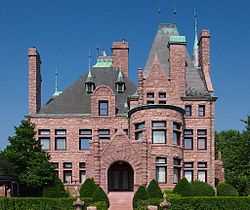George W. Van Dusen

George Washington Van Dusen (July 10, 1826–??) was a grain dealer who was one of the many businessmen to become rich from the milling boom in Minnesota in the second half of the 19th century. Van Dusen was from a New York family, and his father Laurence had been born in Byron Center, Genesee County, New York.[1]
In 1858, George Van Dusen began working as a grain buyer in Wisconsin. He followed the trade westward to Rochester, Minnesota where in 1865 he began building grain elevators and warehouses along railroad lines under his G.W. Van Dusen & Co.[2] The Winona and St. Peter Railroad was completed through town to Kasson, Minnesota that same year. Just east of Kasson was a settlement known as Bear Grove. Van Dusen built a warehouse there,[3] and is credited with renaming the village to its present name of Byron after the town of Port Byron, New York, where he once lived,[4] though he may have also thought of his father's birthplace.[1] The Chicago and North Western Railway gained control of the Winona and St. Peter in 1867, and the line continued to grow westward.
In 1888, Van Dusen was president and general manager of both his eponymous company, then in control of more than 90 elevators stretching from Winona to Pierre, South Dakota, and the Star Eleveator Company. That year, the stock of the two companies was sold to English investors in London,[2] and merged by 1889 with Charles M. Harrington's Minneapolis company to become Van Dusen-Harrington.[5][6] This eventually became part of the Peavey Company, acquired by ConAgra in 1982.[7]
Van Dusen was married three times. He married Mary Armstrong around 1848, Percis Barden around 1855, and then Nancy Barden on November 29, 1860.[1]
References
- ↑ 1.0 1.1 1.2 Albert Harrison Van Deusen (1912). Van Deursen Family, Volume 1. New York: Frank Allaben Genealogical Company. Retrieved January 1, 2010.
- ↑ 2.0 2.1 Moses Foster Sweetser. Moses King, ed. King's Handbook of the United States. New York/Buffalo: The Matthews-Northrup Co. Retrieved January 1, 2010.
- ↑ Horace Austin, John L. Gibbs, George L. Becker (1888). Annual Report of the Railroad and Warehouse Commissioners of Minnesota to the Governor For the Year Ending June 30, 1888. St. Paul: Pioneer Press Company. Retrieved January 1, 2010.
- ↑ William H. Stennett (1908). A History of the Origin of the Place Names Connected with the Chicago and North Western & Chicago, St. Paul, Minneapolis & Omaha Railways. Chicago. Retrieved January 1, 2010.
- ↑ Little Sketches of Big Folks, Minnesota 1907. St. Paul/Minneapolis/Duluth: R. L. Polk & Co. Retrieved January 1, 2010.
- ↑ "Charles M. Harrington House". Minneapolis Heritage Preservation Commission. February 2007. Retrieved January 1, 2010.
- ↑ "Peavey Company: An Inventory of Its Records". Minnesota Historical Society. Retrieved January 1, 2010.